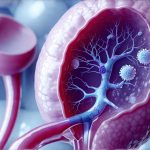Acute interstitial nephritis (AIN) is a challenging diagnosis often requiring invasive kidney biopsy for definitive confirmation. It represents inflammation within the kidneys’ interstitial space, impacting their ability to properly filter waste and regulate fluids. This condition can arise from various causes, including medications (most commonly antibiotics and proton pump inhibitors), infections, autoimmune diseases, and less frequently, malignancy. Early detection is crucial because untreated AIN can lead to chronic kidney disease and even kidney failure, making timely diagnosis a significant clinical concern for nephrologists and other healthcare professionals. The subtle presentation of AIN – often mimicking other more common conditions – adds to the diagnostic difficulty, prompting ongoing research into non-invasive methods for earlier identification.
Currently, diagnosing AIN relies heavily on clinical suspicion based on patient history (particularly recent medication use), symptoms like fever, rash, and decreased urine output, along with laboratory findings such as elevated creatinine levels and the presence of white blood cells in the urine. However, these indicators are not specific to AIN, meaning other kidney conditions can produce similar results. This leads to a dependence on kidney biopsy – considered the gold standard for diagnosis – which is invasive, carries inherent risks, and isn’t always feasible or desirable for every patient. Therefore, exploration of readily available imaging modalities like ultrasound as potential diagnostic aids is an active area of investigation in nephrology. The question remains: can ultrasound reliably detect the subtle changes associated with acute interstitial nephritis?
Ultrasound’s Role in Kidney Imaging
Ultrasound, a widely accessible and relatively inexpensive imaging technique, has long been used to assess kidney structure and function. Its utility stems from its ability to differentiate between cortical and medullary regions of the kidney, providing information about size, shape, and echogenicity (how sound waves are reflected). While traditionally employed for detecting cysts, stones, or obstructions, researchers have begun exploring whether ultrasound can identify changes indicative of inflammation in AIN. The rationale is that inflammatory processes within the interstitium might alter renal tissue characteristics, detectable as alterations in echogenicity or blood flow on ultrasound imaging.
However, it’s important to acknowledge the inherent limitations of ultrasound when evaluating for subtle inflammatory changes. Ultrasound’s sensitivity depends significantly on operator skill and equipment quality. Furthermore, factors like patient body habitus (size and build) can impact image clarity. The kidney’s location retroperitoneally and potential overlying bowel gas also complicate visualization. Therefore, while ultrasound is excellent for identifying structural abnormalities, detecting early inflammatory changes in AIN presents a significant challenge. Existing studies examining the use of ultrasound in AIN diagnosis have yielded mixed results, with some suggesting subtle findings can be detected but are not consistently reliable enough to replace biopsy.
The potential benefits of using ultrasound lie in its non-invasive nature and availability. If ultrasound could confidently identify patients who likely have AIN, it could triage patients for further evaluation (including biopsy) or monitor treatment response. This would reduce the number of unnecessary biopsies performed, minimizing patient risk and healthcare costs. Current research is also focused on advanced ultrasound techniques like contrast-enhanced ultrasound (CEUS) which uses microbubble contrast agents to improve visualization of renal blood flow and potentially highlight areas of inflammation.
Identifying Potential Ultrasound Findings in AIN
Several subtle findings on ultrasound have been proposed as potential indicators of AIN, although none are definitively diagnostic on their own. These include: – Increased renal cortical thickness – suggesting edema or inflammation. – Decreased corticomedullary differentiation – meaning the distinction between the outer cortex and inner medulla becomes less clear. This is thought to occur because inflammation blurs the normal architectural differences. – Increased echogenicity of the renal parenchyma – indicating a more dense, brighter appearance on ultrasound due to inflammation and fibrosis. – Reduced or absent Doppler flow in some areas – suggesting compromised blood supply due to interstitial swelling or inflammation.
It’s crucial to remember these findings are not specific to AIN; they can also be seen in other kidney diseases like acute tubular necrosis (ATN) or chronic kidney disease. The diagnostic challenge lies in differentiating between these conditions based on ultrasound alone, which is often impossible. Therefore, interpreting ultrasound findings requires careful consideration of the patient’s clinical presentation and laboratory results. For example, a patient with recent antibiotic use presenting with elevated creatinine who shows decreased corticomedullary differentiation on ultrasound would have a higher probability of AIN than someone without those risk factors.
The Role of Contrast-Enhanced Ultrasound (CEUS)
Contrast-enhanced ultrasound utilizes microbubble contrast agents injected intravenously to enhance visualization of renal blood flow and perfusion. In the context of AIN, CEUS aims to detect areas of reduced or altered perfusion caused by inflammation and interstitial edema. Studies have shown that CEUS can identify regions with decreased blood flow in kidneys affected by AIN, potentially differentiating it from other causes of acute kidney injury where perfusion might be preserved.
The advantage of CEUS lies in its ability to provide more detailed information about renal microvasculature than conventional ultrasound. It allows for assessment of cortical and medullary perfusion separately, which is important since AIN often affects the medulla initially. However, CEUS isn’t without limitations. The contrast agents are eliminated relatively quickly, meaning imaging must be performed promptly after injection to capture relevant findings. Additionally, the interpretation of CEUS images requires specialized training and expertise. While promising, CEUS remains an evolving technique in the diagnosis of AIN, and more robust studies are needed to determine its clinical utility.
Limitations and Future Directions
Despite ongoing research, ultrasound’s ability to reliably detect acute interstitial nephritis remains limited. The lack of specificity is a major hurdle – many other kidney conditions can produce similar ultrasound findings. Operator dependence and technical limitations further complicate interpretation. Currently, ultrasound should not be used as a standalone diagnostic tool for AIN. It can, however, play a valuable role in the initial evaluation of patients with acute kidney injury, helping to rule out obstructive causes or identify other structural abnormalities.
Future research directions include: – Developing standardized protocols for ultrasound examination and interpretation. – Utilizing artificial intelligence (AI) algorithms to analyze ultrasound images and improve diagnostic accuracy. AI could potentially identify subtle patterns indicative of AIN that are difficult for humans to detect. – Conducting larger, prospective studies comparing the performance of ultrasound (including CEUS) with kidney biopsy as the gold standard. – Investigating novel ultrasound techniques like shear wave elastography which measures tissue stiffness and may be sensitive to inflammatory changes. Ultimately, a multimodal approach combining clinical assessment, laboratory findings, imaging modalities (ultrasound, CT, MRI), and potentially biopsy remains crucial for accurate diagnosis and management of acute interstitial nephritis.





















